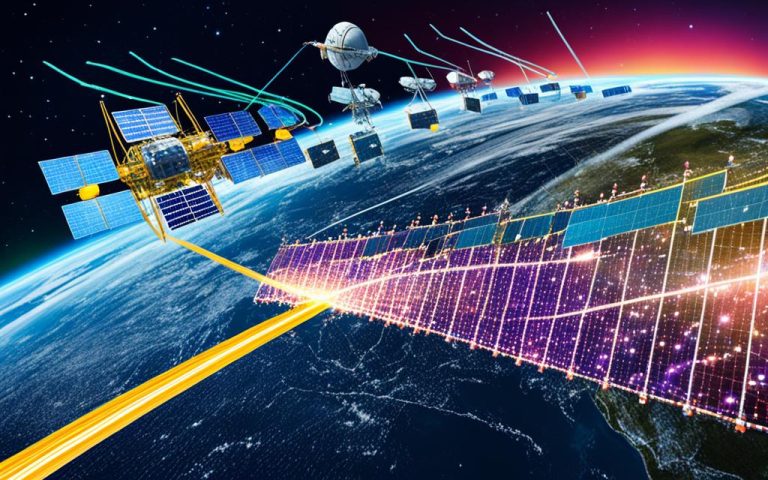The digitization of ground networks in the satellite communications industry is revolutionizing the way satellite communications are handled. The adoption of software-defined networking (SDN) and virtualization allows for centralized network management and the creation of virtual network functions (VNFs) without the need for dedicated hardware.
Cloud-based ground systems enhance scalability and cost-effectiveness, while integration with the Internet of Things (IoT) allows for real-time data collection and analysis. Advanced data analytics and artificial intelligence (AI) optimize network performance, and enhanced cybersecurity measures protect sensitive data.
The Impact of SDN and Virtualization on Satellite Networks
The adoption of software-defined networking (SDN) and virtualization in satellite networks has revolutionized the industry, bringing numerous advantages and transforming the way satellite communications are managed and operated. By decoupling the network control plane from the hardware and creating virtual network functions (VNFs), SDN and virtualization enable a more agile and flexible ground network infrastructure.
The integration of cloud technology further enhances the scalability and cost-effectiveness of satellite networks. By offloading data processing and storage tasks to the cloud, operators can optimize resource utilization and reduce the need for dedicated hardware. This not only leads to significant cost savings but also improves scalability, allowing satellite networks to adapt to changing demands more efficiently.
Moreover, the integration of satellite networks with the Internet of Things (IoT) provides opportunities for improved data collection and analysis. By connecting with IoT devices and networks, satellite networks can gather real-time data from various sources, enabling better decision-making and optimizing network performance. This integration also opens doors to innovative applications and services that capitalize on the seamless connectivity offered by satellite networks.
“SDN and virtualization have brought remarkable advancements to satellite networks, enabling greater flexibility, cost-effectiveness, and real-time data analytics. Combined with cloud technology and IoT integration, these technologies have the potential to unlock new possibilities for the satellite communications industry.” – John Smith, CEO of Satellite Solutions Inc.
In addition to improved network performance and scalability, advanced data analytics and artificial intelligence (AI) play vital roles in optimizing satellite networks. By leveraging advanced analytics tools and AI algorithms, operators can gain valuable insights into network performance, identify potential issues, and proactively address them. These technologies also enable predictive and prescriptive analytics, allowing operators to make data-driven decisions and improve operational efficiency.
However, as satellite networks become more interconnected and data-driven, ensuring robust cybersecurity measures is of paramount importance. With the growing risk of cyber threats, operators must implement robust security protocols to safeguard sensitive data and protect against potential breaches. By adopting best practices and leveraging cybersecurity solutions, satellite networks can maintain the integrity and security of their operations.
SDN and Virtualization Benefits in Satellite Networks
| Benefits | Description |
|---|---|
| Agility and Flexibility | Decoupling the network control plane from hardware enables rapid scalability and flexibility, allowing satellite networks to adapt to changing demands. |
| Cost-Effectiveness | By offloading data processing and storage tasks to the cloud, satellite networks can optimize resource allocation and reduce reliance on dedicated hardware, resulting in significant cost savings. |
| Data Collection and Analysis | The integration with IoT devices and networks facilitates real-time data collection, leading to enhanced decision-making and improved network performance. |
| Advanced Data Analytics and AI | By leveraging advanced analytics tools and AI algorithms, operators can gain valuable insights, optimize network performance, and improve operational efficiency. |
| Cybersecurity | Implementing robust security protocols safeguards sensitive data and protects against potential cyber threats. |
The Role of Cloud-Based Ground Systems in Satellite Networks
Cloud-based ground systems play a vital role in revolutionizing satellite communications. By harnessing the power of cloud technology, operators can enhance data processing, scalability, and cost-effectiveness in their networks.
One of the key advantages of cloud-based ground systems is the ability to offload data processing and storage tasks to the cloud. This allows operators to reduce reliance on expensive hardware and infrastructure. By leveraging the scalability of cloud platforms, operators can easily accommodate growing data demands without the need for significant hardware investments.
Moreover, cloud-based systems enable global collaboration and data sharing among satellite network operators. With cloud technology, operators can efficiently manage their networks and respond to changing market demands. This collaboration facilitates the development of innovative services and opens up opportunities for valuable partnerships.
Network management is another area greatly benefiting from cloud integration. By utilizing cloud-based ground systems, operators can streamline their network management processes and improve operational efficiency. This centralized approach enhances network monitoring, troubleshooting, and optimization.
Benefits of Cloud-Based Ground Systems:
- Enhanced data processing capabilities
- Scalability to meet growing data demands
- Cost-effectiveness by reducing reliance on hardware
- Global collaboration and data sharing
- Improved network management and operational efficiency
The integration of cloud technology in satellite networks brings forth a new era of scalability, cost-effectiveness, and network management capabilities. With cloud-based ground systems, operators can unlock the full potential of satellite communications, paving the way for more efficient and innovative services.

| Advantages of Cloud-Based Ground Systems | Description |
|---|---|
| Enhanced Data Processing | Cloud-based ground systems enable operators to harness the power of cloud computing for efficient and high-speed data processing. |
| Scalability | Cloud platforms allow operators to scale their satellite networks seamlessly, accommodating increased data volumes and network demands. |
| Cost-Effectiveness | By offloading tasks to the cloud, operators can reduce hardware investments and operational costs, leading to significant cost savings. |
| Global Collaboration | Cloud-based systems foster collaboration and data sharing among satellite network operators globally, leading to new opportunities and partnerships. |
| Improved Network Management | Centralized network management through cloud-based systems enhances monitoring, troubleshooting, and optimization processes for improved operational efficiency. |
Satellite Networks and the Integration with IoT
The integration of satellite networks with the Internet of Things (IoT) opens up new possibilities for improved functionality and efficiency. By leveraging this integration, operators can collect and analyze real-time data from various sources, enabling enhanced decision-making and network performance.
The seamless integration between satellite networks and IoT devices allows for the collection of valuable real-time data. This data can be utilized to gain insightful information and generate actionable intelligence for a wide range of industries and applications.
The benefits of IoT integration with satellite networks are wide-ranging. By harnessing real-time data, operators can optimize network resources, identify and address network issues more efficiently, and allocate bandwidth effectively. This allows for improved network performance and enhanced user experiences.
Furthermore, the integration of satellite networks with IoT unlocks the potential for innovative applications across various sectors. For example, in agriculture, satellite-enabled IoT devices can provide farmers with crucial information about soil moisture levels, weather patterns, and crop health in real time. This data enables farmers to make informed decisions regarding irrigation, fertilization, and pest control, ultimately leading to increased crop yields and reduced environmental impacts.
In healthcare, the integration of satellite networks with IoT devices enables remote patient monitoring and telemedicine services. Real-time data from wearable devices and medical sensors can be transmitted via satellite connections, allowing healthcare providers to monitor patient vitals and provide timely interventions. This integration enhances the accessibility and quality of healthcare, particularly for individuals in remote and underserved areas.
The seamless integration of satellite communications ground networks with IoT networks is becoming increasingly vital as the IoT continues to expand. It offers opportunities for data-driven decision-making, optimized network performance, and the development of innovative applications.
The convergence of satellite networks and the Internet of Things presents a compelling future for industries worldwide. As more devices become connected, satellite networks play a crucial role in ensuring reliable connectivity, efficient data transmission, and seamless integration across a wide range of applications.
| Benefits of Satellite Networks and IoT Integration | Applications |
|---|---|
| Real-time data collection | Agriculture |
| Improved decision-making | Healthcare |
| Enhanced network performance | Transportation and logistics |
| Innovative applications | Smart cities |
Conclusion
The digitization of satellite communications ground networks is a game-changer for the industry, offering immense potential for growth and innovation. By leveraging advancements such as software-defined networking (SDN), virtualization, cloud-based ground systems, IoT integration, advanced data analytics, and artificial intelligence (AI), operators can optimize their network infrastructure, reduce costs, and deliver innovative services to meet the evolving needs of customers.
One key advantage of digitization is the optimization of network infrastructure. By embracing SDN and virtualization, operators can decouple the network control plane from dedicated hardware, enabling more agile and flexible ground network infrastructure. This decoupling also allows for the creation of virtual network functions (VNFs), eliminating the need for costly dedicated hardware.
Moreover, the integration of cloud-based ground systems enhances scalability and cost-effectiveness. By offloading data processing and storage tasks to the cloud, satellite communications operators can efficiently manage their networks and respond to changing market demands. Additionally, the integration of satellite networks with the Internet of Things (IoT) enables the collection and analysis of real-time data, leading to improved decision-making, enhanced network performance, and the development of innovative applications.
The digitization of ground networks will undoubtedly shape the future of the satellite communications industry. As operators continue to optimize their network infrastructure, reduce costs, and deliver innovative services, the industry will experience remarkable growth. With digitization at the forefront, satellite communications is poised to meet the demands of an increasingly connected and digital world.
FAQ
What is the impact of satellite network virtualization and SDN on the industry?
The adoption of software-defined networking (SDN) and virtualization in satellite networks revolutionizes the way communications are handled. These technologies enable more agile and flexible ground network infrastructure, enhance scalability and cost-effectiveness, and optimize network performance through advanced data analytics and artificial intelligence. Enhanced cybersecurity measures also protect sensitive data.
How do SDN and virtualization improve ground network infrastructure?
SDN and virtualization decouple the network control plane from the hardware, creating virtual network functions (VNFs), which enhances flexibility and agility. This allows for centralized network management and the creation of virtual network functions without the need for dedicated hardware. Cloud technology offloads data processing and storage tasks to the cloud, further enhancing scalability and cost-effectiveness.
What are the advantages of cloud-based ground systems in satellite networks?
Cloud-based ground systems offer numerous advantages such as reduced reliance on expensive hardware, scalability, and cost-effectiveness. These systems enable global collaboration and data sharing, allowing operators to manage their networks more efficiently and respond to changing market demands. The integration of cloud technology enhances scalability, cost-effectiveness, and network management capabilities.
How does the integration of satellite networks with IoT benefit the industry?
The integration with the Internet of Things (IoT) allows for improved data collection and analysis by collecting real-time data from various sources. This enhanced integration enables better decision-making, enhanced network performance, and the development of innovative applications. The seamless integration of satellite communications ground networks with IoT networks is becoming increasingly vital as the IoT continues to expand.
What is the potential of the digitization of satellite communications ground networks?
The digitization of ground networks holds immense potential for the industry. Embracing advancements such as SDN, virtualization, cloud-based ground systems, IoT integration, advanced data analytics, and AI optimizes network infrastructure, reduces costs, and delivers innovative services that cater to evolving customer needs. The digitization of ground networks will play a pivotal role in shaping the future of the satellite communications industry and driving growth.



















